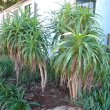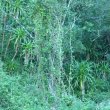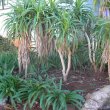| Botanical Name |
|
| Family |
Dracaenaceae - The dragon tree family. |
| Pronunciation |
dra-SEE-nah ah-let-rih-FOR-mis |
| Common Name(s) |
English: Large-leaved dragon tree
Afrikaans: Grootblaardrakeboom
IsiXhosa: intelezi; ishwadi; Umkhoma-khoma
Igonsi-lehlathi; Itokothoko
Sesotho sa Leboa: Photsoloma
|
| Plant Group |
- Tree A woody, self-supporting perennial plant usually with a single main stem and generally growing more than 6 meters tall.
|
| Plant Size |
- Very Small
| Tree | 3m to 4m |
| Shrub | 25cm to 50cm |
| Perennial/ground cover | Up to 10cm |
| Bulb | 10cm to 20cm |
| Succulent | Up to 5cm |
|
| Position |
- Canopy Shade Canopy shade is found below closely grown trees where some light filters through. Ideal for the protection of herbaceous plants.
- Deep / Full Shade Shade below spreading evergreen trees where sun's rays are unable to penetrate the canopy at any time. For light sensitive plants
- Light or Dappled Shade Found below trees with sparse, open foliage. Ideal for the protection of herbaceous plants.
- Partial Shade The area is in shade for part of the day and in full sun for part of the day.
|
| General Information |
- Attractive fruits, berries or seeds Brightly coloured fruits or berries increase and extend the visual impact of the plant and are especially attractive to birds and other small wildlife.
- Drought Tolerance: Moderate The plant is moderately adapted to arid conditions and can survive short periods of drought and high temperatures without extra water.
- Evergreen Plants that have leaves all year round.
- Fragrant / Aromatic These plants posses a strong, usually pleasant odour.
- Frost: Tender A plant that will not survive any frost or low winter temperatures.
- Roots Non-invasive Safe to plant near pools, paving, walls or buildings.
- Water Moderate These plants will need some extra watering compared to water-wise plants. Plant them together, in at least some shade and in a convenient proximity to the house so that grey water can be utilised during times of drought.
|
| Specific Information |
Dracaena aletriformis is an evergreen, usually single-stemmed small tree. The shiny, leathery, strap-shaped leaves are crowded towards the ends of the stems. The leaves can grow up to 1 m long. Being pollinated by a moth, the flowers open in the late afternoon. This relatively fast-growing plant prefers shade and is always found in humus-rich soil. Draceana will tolerate low light conditions, making it useful as a container plant for indoors or on a shaded patio,
|
| Ad Break |
|
| Flowers |
| Description |
tubular, green petals opening to reveal long white stamens, on tall, branched spikes
|
| Season |
- Summer Plants will seldom bloom for the entire season as given in the list, but should flower during a period within these parameters.
|
| Colour |
|
| Growth Rate |
- Moderate to Fast Specifying growth rate can be very misleading as there is considerable variation of growth rate depending on type and species of plant, available water, supplementary feeding, mulching and general care, as well as the plants suitability and adaptability to the garden environment.
|
| Plant Uses |
- Accent or Focal Point A plant used to attract the attention because of its colour or form.
- Attracts bees, butterflies or other insects This plant attracts insects which can be food for birds or other creatures in your garden.
- Attracts Birds This plant will attract birds.
- Container Trees, shrubs and ornamental species that can adapt to growing in a restricted environment.
- Filler Either a fast growing tree or shrub used temporarily to fill in an area while the permanent plants grow to a desired size, or a plant used to fill gaps in borders or beds.
- Foliage Plant Plants grown because their foliage is colorful or unique. Many of these plants have insignificant flowers.
- Suitable for coastal gardens Plants adapted to dry, sandy soil, forceful wind, limited rainfall and intense sunlight.
- Suitable for smaller gardens Such plants do not have invasive root systems, remain small or controllable and can often be grown in containers.
- Water Features These plants may have dramatic, lush foliage or graceful form. They do not shed excessive leaves and do not have invasive root systems.
- Wild Garden An indigenous garden planted for the benefit of wildlife and birds. Provides food, water, a variety of mini-biomes and no poisonous chemicals are used.
|
| Distribution and Habitat |
from Port Elizabeth to KwaZulu-Natal, in coastal dune forest and densely wooded ravines, and from Swaziland to eastern and northern Mpumalanga, in deep shade along streams and in shady places in the bushveld
|
| Planting Suggestions |
|
| Medicinal Uses |
In the Eastern Cape, the crushed root of Dracaena aletriformis is used as a wash to banish evil spirits.
|
| Ad Break |
|







Discuss this plant
Share knowledge, ask a question or give an experience.